DONNY HATHAWAY / “Someday We’ll All Be Free”
The Sixties, the Civil Rights Movement. Having a dream. 1964, the Civil Rights Act. 1965, the Voting Rights Act. The mid-Sixties was both a culmination and an upsurge. De jure desegregation was achieved. De facto segregation was in a mopping up phase—or so we thought back then. 1966 was a year of major transition, the birth of the Black Power movement. In 1965, Malcolm was assisinated. In 1968, Dr. King’s head was damn near blown off. Vietnam was in full effect. By the end of the Sixties, all of the old certainties were gone, cities from coast to coast were aflame. And yet, when the Seventies arrived, rather than despair, there was an electric current of confidence and optimism coursing through the heart and veins of Black America.
Black was blacker, badder and more beautiful than it had been in centuries on these shores. Everything we did, every organization, every individual, to one degree or another, reflected this new wave, this clenched-fist self-determination. Even Soul Train looked and sounded like a political party. For the descendants of enslaved Africans struggling for freedom, justice and equality, the period from the late Sixties to the mid-Seventies was the most optimistic time of the twentieth century.
This period produced three great anthems: 1. "Young, Gifted and Black," 2. "Say It Loud (I’m Black And I’m Proud)," and 3. Donny Hathaway’s classic “Someday We’ll All Be Free.” Here, for your edification and inspiration are seven versions of the classic, kicking off with the original by Donny.
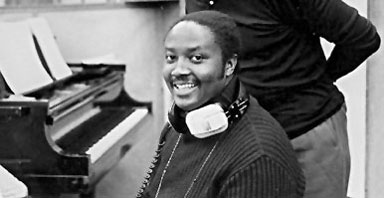 When Donny Hathaway wrote and exuberantly sang, “Never mind your fears / Brighter days will soon be here / Take it from me / Someday we’ll all be free” he was neither preaching to the choir nor bucking up the doubters and non-believers. This was an anthem. An anthem voicing a general aspiration, an assurance, that what we seek will be found. The lyrics are hip. The melody, high-flying and optimistic. Never mind that Donny ended up committing suicide, at that moment, he believed. We believed. All of us believed in the future. And ultimately, the enduring strength of this song is that it appeals to that perennial emotion purported to spring eternal from each human breast.
When Donny Hathaway wrote and exuberantly sang, “Never mind your fears / Brighter days will soon be here / Take it from me / Someday we’ll all be free” he was neither preaching to the choir nor bucking up the doubters and non-believers. This was an anthem. An anthem voicing a general aspiration, an assurance, that what we seek will be found. The lyrics are hip. The melody, high-flying and optimistic. Never mind that Donny ended up committing suicide, at that moment, he believed. We believed. All of us believed in the future. And ultimately, the enduring strength of this song is that it appeals to that perennial emotion purported to spring eternal from each human breast.
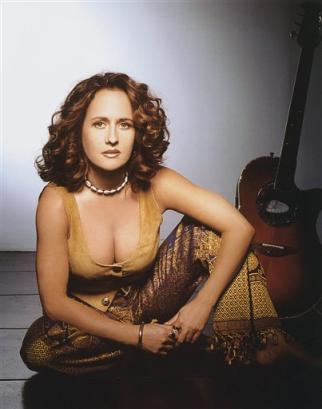 Teena Marie, “the” quintessential blue-eyed soul singer, offers a soaring snippet of Donny’s song (available on the expanded re-issue of Teena’s Motown LP It’s Magic). Actually, this version of the song’s first verse was used as an introduction for an extended version of “Déjà Vu.” She pulls out all the stops on a long, loud high note blast. I wish she had sung the whole song, but this intro is indicative of the power of the song: here was a young white girl singing a black anthem and the audience, which undoubtedly included a healthy sampling (most likely a majority) of Black folk, were deep into it, thoroughly moved by it.
Teena Marie, “the” quintessential blue-eyed soul singer, offers a soaring snippet of Donny’s song (available on the expanded re-issue of Teena’s Motown LP It’s Magic). Actually, this version of the song’s first verse was used as an introduction for an extended version of “Déjà Vu.” She pulls out all the stops on a long, loud high note blast. I wish she had sung the whole song, but this intro is indicative of the power of the song: here was a young white girl singing a black anthem and the audience, which undoubtedly included a healthy sampling (most likely a majority) of Black folk, were deep into it, thoroughly moved by it.
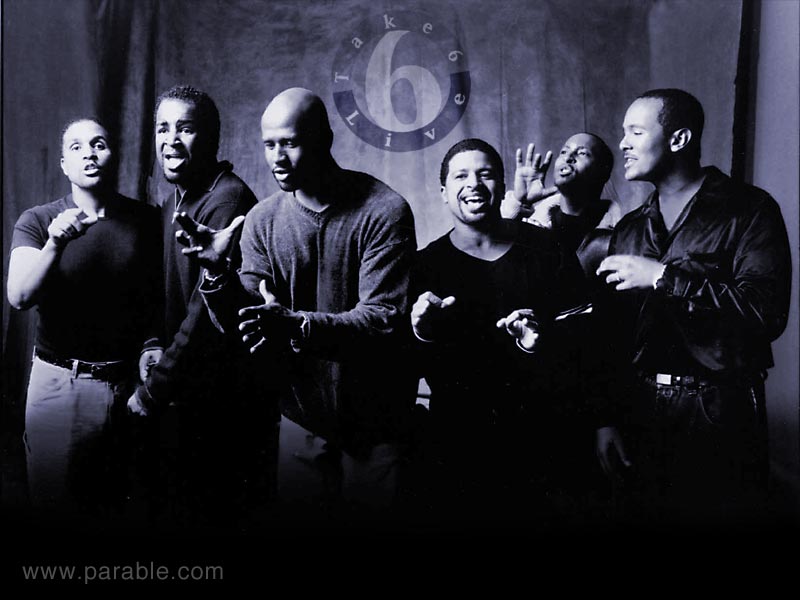 From Teena Marie we segue right into the Seventh Day Adventist vocal group, Take 6. Their version includes the deep bass, jazzy chords and harmonic modulations that are the group’s trademarks. Plus, there is a cameo appearance from Donny Hathaway’s daughter Lalah Hathaway. I am particularly appreciative of the way this arrangement’s sweeping harmonies uplift the soaring lead voices. I find it paradoxical that the most religious-based of all the performers uses jazz techniques for their approach.
From Teena Marie we segue right into the Seventh Day Adventist vocal group, Take 6. Their version includes the deep bass, jazzy chords and harmonic modulations that are the group’s trademarks. Plus, there is a cameo appearance from Donny Hathaway’s daughter Lalah Hathaway. I am particularly appreciative of the way this arrangement’s sweeping harmonies uplift the soaring lead voices. I find it paradoxical that the most religious-based of all the performers uses jazz techniques for their approach.
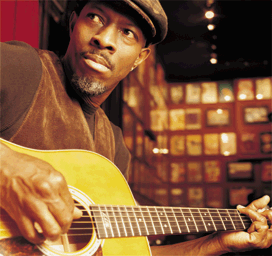 Neo-retro bluesman Keb’ Mo’ (by which I mean, he’s a young man playing in a traditional country blues style) sounds most like he just arrived from up country and is telling his city-bred cousin, hey, everything is going to be alright. Contrasted to Take 6, this is an exceedingly simple arrangement, yet it is equally effective, probably because Keb’ Mo’ is really feeling it and because he knows how to project his sincere emotions without Teena Marie’s flashy emoting or Take 6’s dazzling technique.
Neo-retro bluesman Keb’ Mo’ (by which I mean, he’s a young man playing in a traditional country blues style) sounds most like he just arrived from up country and is telling his city-bred cousin, hey, everything is going to be alright. Contrasted to Take 6, this is an exceedingly simple arrangement, yet it is equally effective, probably because Keb’ Mo’ is really feeling it and because he knows how to project his sincere emotions without Teena Marie’s flashy emoting or Take 6’s dazzling technique.
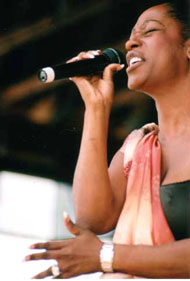 R&B queen Regina Belle offers up a near-symphonic production that opens and closes with Marvin Gaye’s “Save The Children.” It’s an inspired medley. Regina could be Anita Baker’s younger sibling. Regina’s voice is pitched higher and is lighter than Anita’s but they both love upward glissandos. Some folk find this approach a bit melodramatic, but I think this is one of Regina’s better efforts.
R&B queen Regina Belle offers up a near-symphonic production that opens and closes with Marvin Gaye’s “Save The Children.” It’s an inspired medley. Regina could be Anita Baker’s younger sibling. Regina’s voice is pitched higher and is lighter than Anita’s but they both love upward glissandos. Some folk find this approach a bit melodramatic, but I think this is one of Regina’s better efforts.
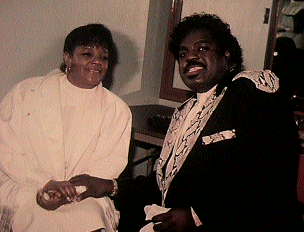 New Orleans gospel icon Raymond Myles gives us the funkiest version, even though it is firmly planted in the gospel tradition, including a spoken homily interlude. Gunned down in a controversial car-jacking episode, Raymond Myles was immensely gifted with not only a talent for singing, but also a musical vision that was both broad and deep. He would incorporate diverse and divergent musical traditions into his performances, plus he could wear out the most seasoned veteran with his ability to play keyboards and to arrange and direct his backup choir, all of which was in support of an old-school vocal style that made both men and women shout and weep, moan and cheer. Raymond Myles was phenomenal, as is his reading of this classic.
New Orleans gospel icon Raymond Myles gives us the funkiest version, even though it is firmly planted in the gospel tradition, including a spoken homily interlude. Gunned down in a controversial car-jacking episode, Raymond Myles was immensely gifted with not only a talent for singing, but also a musical vision that was both broad and deep. He would incorporate diverse and divergent musical traditions into his performances, plus he could wear out the most seasoned veteran with his ability to play keyboards and to arrange and direct his backup choir, all of which was in support of an old-school vocal style that made both men and women shout and weep, moan and cheer. Raymond Myles was phenomenal, as is his reading of this classic.
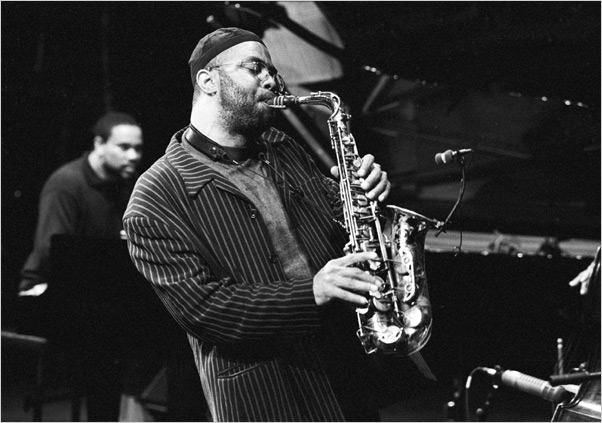 We close with saxophonist Kenny Garrett putting percussion beneath the song to give it an exotic, uplifting lilt. When I first heard Kenny’s version, I wanted to hear more saxophone, or should I say, I wanted to hear more jazz from his saxophone, but then I realized that this was not meant to be a jazz rendition but rather has both feet planted in the instrumental R&B bag including tabourined back-beats on the release of the song and short, stabbing phrasing on the closing vamp.
I live in New Orleans. It’s hard to be cheerful and optimistic, but listening to this set always improves my outlook. I hope these versions of Donny Hathaway’s classic will do the same for you. Someday….
—Kalamu ya Salaam
Just singing a song
When you call Teena Marie a "young white girl singing a black anthem," it reminds me of whoever it is that referred to Jimi Hendrix as "a dead guitar player." Technically true, but.... Teena is an honorary soul sister, period. Yeah, she may actually be a white girl from Santa Monica, but she's also a living legend of black music. With all due respect to my man Donnie, folk were feeling Teena not because of the song she was singing, but because of the way she was singing the song.
Like Kalamu, I wish Teena's take on "Someday We'll All Be Free" was a lot longer. I can't say the same for the rest of these versions. (Except one...which I'll get to.) Listening to Regina Belle's and Raymond Myles' melodramatic tonations as they made their respective ways through this song made me feel like I was watching the finalé of Star Search (for y'all back-in-the-day types) or American Idol (for the kiddies). They sound professional, talented, polished and boring as hell. While attempting to listen to Raymond Myles' version, I was already squirming in my seat when he broke into his spoken 'rap.' I won't bother commenting on that. Plus, the synth-drums, synth-piano and synth-strings (on both versions) doesn't help matters. Where's the grit? The soul? The sweat? The nastiness? Come on, people. (How Kalamu can call Raymond Myles' cloyingly sweet version "the funkiest" is beyond me.)
The Take 6 and Kenny Garrett versions are pleasant, but I won't be in a hurry to hear them again. Of course, the classic is the classic. Like Chris Rock once said about Lauryn Hill: it's Donny and you can't say nothin' bad about Donny.
We close with saxophonist Kenny Garrett putting percussion beneath the song to give it an exotic, uplifting lilt. When I first heard Kenny’s version, I wanted to hear more saxophone, or should I say, I wanted to hear more jazz from his saxophone, but then I realized that this was not meant to be a jazz rendition but rather has both feet planted in the instrumental R&B bag including tabourined back-beats on the release of the song and short, stabbing phrasing on the closing vamp.
I live in New Orleans. It’s hard to be cheerful and optimistic, but listening to this set always improves my outlook. I hope these versions of Donny Hathaway’s classic will do the same for you. Someday….
—Kalamu ya Salaam
Just singing a song
When you call Teena Marie a "young white girl singing a black anthem," it reminds me of whoever it is that referred to Jimi Hendrix as "a dead guitar player." Technically true, but.... Teena is an honorary soul sister, period. Yeah, she may actually be a white girl from Santa Monica, but she's also a living legend of black music. With all due respect to my man Donnie, folk were feeling Teena not because of the song she was singing, but because of the way she was singing the song.
Like Kalamu, I wish Teena's take on "Someday We'll All Be Free" was a lot longer. I can't say the same for the rest of these versions. (Except one...which I'll get to.) Listening to Regina Belle's and Raymond Myles' melodramatic tonations as they made their respective ways through this song made me feel like I was watching the finalé of Star Search (for y'all back-in-the-day types) or American Idol (for the kiddies). They sound professional, talented, polished and boring as hell. While attempting to listen to Raymond Myles' version, I was already squirming in my seat when he broke into his spoken 'rap.' I won't bother commenting on that. Plus, the synth-drums, synth-piano and synth-strings (on both versions) doesn't help matters. Where's the grit? The soul? The sweat? The nastiness? Come on, people. (How Kalamu can call Raymond Myles' cloyingly sweet version "the funkiest" is beyond me.)
The Take 6 and Kenny Garrett versions are pleasant, but I won't be in a hurry to hear them again. Of course, the classic is the classic. Like Chris Rock once said about Lauryn Hill: it's Donny and you can't say nothin' bad about Donny.
 That leaves us with Keb Mo's version—which, I'm proud to say, was my choice (albeit via a hijacked copy of Kalamu's CD). Keb approaches Donnie's classic with a refreshing lack of either pomp or circumstance. His laid-back realness makes it sound like he and his band just happen to be singing and playing a tune they like. Especially given the melismatic fervor that usually holds sway when this song is performed, I appreciate Keb Mo's reserved yet soulful posture. He's not trying to convince anyhow of his sincerity. He's just singing a song.
—Mtume ya Salaam
That leaves us with Keb Mo's version—which, I'm proud to say, was my choice (albeit via a hijacked copy of Kalamu's CD). Keb approaches Donnie's classic with a refreshing lack of either pomp or circumstance. His laid-back realness makes it sound like he and his band just happen to be singing and playing a tune they like. Especially given the melismatic fervor that usually holds sway when this song is performed, I appreciate Keb Mo's reserved yet soulful posture. He's not trying to convince anyhow of his sincerity. He's just singing a song.
—Mtume ya Salaam
This entry was posted on Sunday, June 11th, 2006 at 12:00 am and is filed under Classic. You can follow any responses to this entry through the RSS 2.0 feed. You can leave a response, or trackback from your own site.
5 Responses to “DONNY HATHAWAY / “Someday We’ll All Be Free””
June 11th, 2006 at 5:26 am
Lord, Donny Hathaway’s music could touch one’s soul. And Lalah has such a beautiful voice. Thanks for sharing this 🙂
June 11th, 2006 at 8:37 am
Aside from the classic version, my best is on the Lalah/Take 6 rendition. Take 6 are my favorite vocal group ever, bar NONE, and Lalah’s appearance on the song fulfills far more than nostalgic requirements. Their version, to me, most clearly communicates the HOPE conveyed in the lyrics for a new generation of listeners. Some of the other versions plod along too much to feel uplifting in the end.
And Teena Marie is also one of my faves from my youth, but hearing her recent releases reminds me of a hilarious scene from the movie “High Fidelity” where Jack Black’s character asks John Cusack’s about whether the listening audience can (or should) forgive Stevie Wonder for some of his 80s musical transgressions because of the other classic material he’s created. Teena is traveling that same path.
June 11th, 2006 at 12:01 pm
i agree that donny’s version can’t be touched — he owns it. but i like both take 6’s and keb mo’s remakes. each in its own way does what it’s supposed to do: move the listener. (btw, that last photo of keb mo is simply gorgeous.)
i have to say, though, that listening to this song again and again this morning, with the sunday times’ crazy headlines still rattling in my mind, i’m feeling anything but optimistic. we seem to be farther away from the goal of donny’s anthem than ever — or, if we are closer, now moving away from it, rather than towards it. for strength, i’ll grasp those last few seconds of take 6 and lalah singing “hold on, hold on…”
June 12th, 2006 at 12:47 pm
Beautiful…and what is ironic is that the author and famed singer of this song committed suicide. That in itself suggests that even with the song and its optimism, it wasn’t enough or was it.
Now I know the readers of this site are ready to blast me for such an intro, but truth be told, that’s what makes Donnie’s version so inspiring. The fact that a man who was going through depression could produce something like this. It is haunting and reassuring to listen to his version and then to the Take 6/Lalah Hathway version back-to-back.
The others, while very creative don’t touch these two – even Keb Mo’. I was a little disappointed in the Raymond Myles’ version, because it starts up with so much promise…even with the choir. It is too Marvin Gaye/Teddy Pendergrass-esque instead of a song of Hope and Redemption.
June 16th, 2006 at 2:09 am
the keb mo version is refreshing, but too bouncy and too light for the depth of the lyrics. this is possibly b/c i am so accustomed to Donny’s intonations.
regina belle. too much. too much. the lyrics are too lost in all her vocalizing.
mtume, i definitely hear that raymond miles is laying down the meaning of the lyrics. it’s not all histrionics, he is communicating and i appreciate that…
an inconsequential story about the original. when i was a student at NOCCA (New Orleans Center for Creative Arts), Lula, our modern dance teacher, choreographed a dance to this song. we performed it at a school across the river, Walker perhaps. i remember the hand motions from the chorus and the boys in the orchestra pit. while we were on stage performing the boys in the orchestra pit were sitting right below the stage looking up at us. whenever we stretched or leaned back or lifted a leg, they’d say ‘oh, baby don’t do it like that’ or some other such foolishness… so we were trying to emote “someday we’ll all be free” without cracking up laughing.
Leave a Reply
| top |